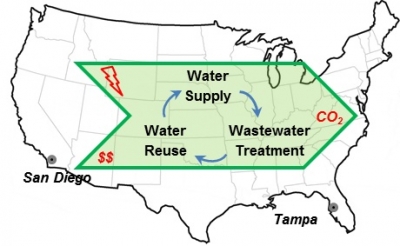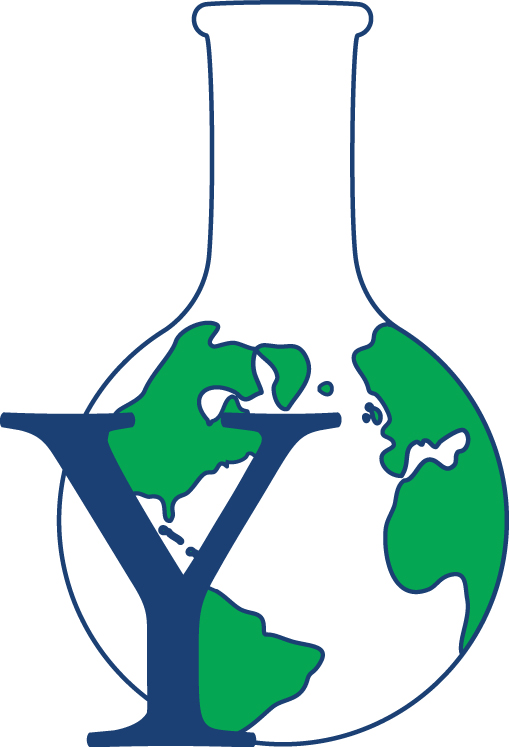
Water
Overview
Based on enhanced estimates of the blue water footprints (WFbS) of nations and economic sectors, our research aims to inform an average consumer, a country, and an economic sector of the potential leverage through altered consumption behaviors on water conservation and water stress mitigation both domestically and abroad.
Study
We developed a hybrid WF accounting model, which enhanced previous estimates of the WFbs of nations and economic sectors with improved spatial coverage and sectoral resolution while considering potential environmental relevance. For consumers in each country, we revealed the geographic sources of their WFbS and the finished commodities that ultimately drove the water consumption. Accordingly, we identified the consumer’s top leverages in water conservation, i.e. the commodity aggregates having the largest contributions to the consumer’s WFb, distinguishing between the implications on domestic and foreign environments. We are reevaluating the roles of the economic sectors in freshwater usage, such as the water-energy nexus, based on the water consumption accounted from both a consumption and production perspective.
Impact
Our work bridges the WF research and demand-side management (DSM) studies, extending the geographical and sectoral scope of conventional DSM measures and enriched WF’s policy relevance. Valid WF estimates have the potential to better inform the development of national policy on water management and food security, and eventually enable a global certification framework and product label that informs individual consumers of their responsibility and leverage in achieving water sustainability.
Overview
The depletion of natural resources and the damage being done to the environment as a result of increased demand for these resources has been felt over the past several decades. Our focus is on the development and implementation of a universal and sustainable heavy metal remediation technology to offset the risks posed by wastewater runoff from anthropogenic practices.
While many technologies for specific metal remediation already exist, there is no single technology that addresses a large variety of related contaminants. Current efficient removal technologies have the drawback of being highly specific, and this lack of universality results in a difficult and unsustainable use-phase as wastewater is often contaminated with many metals.
Study
This project seeks to develop a nanopowder metal oxide-impregnated chitosan bead (MICB) adsorbent to be used for sustainable removal of arsenic and selenium from solution. Chitosan, a waste product from shellfish, also adsorbs metals like mercury, copper, and cadmium which often coexist with arsenic and selenium. The current work attempts to increase the selectivity of MICB adsorbent in highly complex environments, which are commonly seen in wastewater runoffs.
Impact
This technology will allow the removal of a large variety of related contaminants which are currently present in water environments.
Overview
Regulations on inorganic aqueous contaminants are becoming increasingly strict as research brings to light the negative impact of these contaminants on human health and the environment. Inorganic contaminants enter the environment from anthropogenic sources such as mining and industrial waste. The goal of our research is to develop a treatment process that both removes these inorganic contaminants while minimizing negative externalities associated with the process.
Study
We are examining photocatalytic iron oxide nanoparticles as a possible treatment technology for these contaminants. The iron oxide nanoparticles are able to change the form of the contaminant for easier removal as well as remove the contaminant from solution. Furthermore, we are in the process of isolating and synthesizing iron oxide nanoparticles from mine waste, thereby closing industrial loops and turning mine waste into a value-added product.
Impact
Implications from this work extend into other materials research understanding, applications of water splitting and even in biomedical engineering where iron oxide nanoparticles are used extensively.
Overview
The United States is facing growing concerns of water infrastructure degradation: is it economically and environmentally beneficial to build new or repair existing systems?
Study
This research will move towards the idea of sustainable development and sustainable urban water infrastructures by proposing alternatives of urban water infrastructure systems that are resilient to the following:
-
major internal stressors (infrastructure aging)
-
major external stressors (population growth and climate change)
-
costs (economic, resource consumption, and pollution generation)
The research will first be conducted in the context of Tampa, Florida, given the local-specific nature of water science and management, as well as the more rapid population growths and dramatic climate change impacts in coastal cities.
Impact
The research can inform policy makers about different water challenges coming from a variety of U.S. and international cities.
Overview
Energy-Water Nexus Analysis of Enhanced Water Supply Scenarios in Tampa Bay, Florida and San Diego, California.
Increased water demand and scarce freshwater resources have forced communities to seek non-traditional water sources. These challenges are exacerbated in coastal communities where population growth rates and densities in the US are the highest.
Study
 To understand the current management dilemma between constrained surface and groundwater sources and potential new water sources, Tampa Bay, FL (TB) and San Diego, CA (SD) were studied through 2030 accounting for changes in population, water demand, and electricity grid mix.
To understand the current management dilemma between constrained surface and groundwater sources and potential new water sources, Tampa Bay, FL (TB) and San Diego, CA (SD) were studied through 2030 accounting for changes in population, water demand, and electricity grid mix.
These locations were chosen based on their similar population, land area, economy, and water consumption characters, as well as their coastal locations and rising contradictions between water demand and supply.
Three scenarios were evaluated for each study area:
- Maximize traditional supplies
- Maximize seawater desalination
- Maximize non-potable water reclamation; and three types of impacts were assessed: embodied energy, greenhouse gas (GHG) emission and energy cost.
Impact
SD was found to have higher embodied energy and energy cost, but lower GHG emission than TB in most of its water infrastructure systems due to the differences in electricity grid mixes and water resources between the two regions. Maximizing water reclamation was found to be better than either increasing traditional supply or seawater desalination in both regions in terms of the three impact categories.
Overview
Literature from both academic and public sources is considered in order to provide a holistic perspective. There are many tools available for stormwater management, but there is little evidence of systematic design processess and outcomes due to the lack of 1) large-scale environmental performace data; 2) cost-effectiveness studies that include life cycle costs; and 30 pricin and policy structures that engage broader stakeholders.
Study
We presented a decision process based on systems thinking and show where current literature meets decision-making needs, where research gaps exist, and how research needs should be prioritized to support sustainable stormwater infrastructure implementation. We are aslo starting data collection and model development of hydrology in the city of New Haven to test best management practices in model setting.
Impact
A critical review of the science of sustainable stormwater management, including definition of best management practices and low impact developments for stormwater, green infrastructure, as well as sustainable stormwater management; modeling to inform stormwater practice; optimized watershed scale design; and implementation.
This project brings together students, faculty, citizens, and local, state and federal policy-makers in partnership to meet four aims: 1) critical review of current green infrastructure knowledge and implementation; 2) place-based characterization of hydrologic/nitrogen cycling by and socio-economic function of green infrastructure (south-, central- and northeastern urban seaboard); 3) GIS-supported geospatial optimization of hydrologic/nitrogen cycles by varying location of green infrastructure practices; 4) development of decision-support and policy recommendations for best-practice in green infrastructure investment.
Major results from this life cycle analysis research have shown that new stormwater infrastructures can significantly improve water quality and aquatic ecosystem health, but at the cost of added resource consumption and elevated GHG emissions and human toxicity impacts during the infrastructures’ construction, operation, and maintenance phases. Given the impacts of climate change, infrastructures with larger treatment capacity and higher resiliency are needed in order to effectively alleviate the impacts associated with more intense, more frequent stormwater events. Also, improvement in infrastructure design and engineering (e.g. using low-impact or recycled materials or enhancing treatment efficiency) can largely offset the extra environmental impacts caused by the need of infrastructure upsizing. Reducing land imperviousness is an effective substitute to building new stormwater infrastructures. Finally, results have also shown, the assessment and implementation of integrated stormwater infrastructure systems and integrated wastewater and stormwater management can better assist decision makings with tradeoff dilemmas.
Appropriate water reclamation and reuse practices are critical due to increasing water scarcity, concerns about the effect of wastewater discharges on receiving water, and availability of high-performing and cost-effective water reuse technologies. However, incorporation of water reuse schemes into water/wastewater infrastructure systems is a complex decision-making process, involving various economical, technological, and environmental criteria. System dynamics allows modeling of complex systems and provides information about the feedback behavior of the system. We are applying our comprehensive system dynamics model of water/wastewater systems to various cities’ scenarios to determine potential for water reuse.

Although the connections between climate change, water quality and diarrhea seem self-evident, they require the understanding of the complex and trans-disciplinary human, engineered, and natural Water, Sanitation and Hygiene (WASH) system that is typical in developing world communities. In particular, a number of factors need to be considered including global climate change, local hydrology, pathogen microbiology, disease transmission, engineered systems and human behavior aspects.
The study uses an agent-based computer model (ABM) to study the complexity of climate change impacting diarrhea rates. ABM mimics the behavioral rules of people who are collecting water from different water sources which are impacted by the climate change. The quality of collected water is linked to the likelihood of getting diarrhea.
This technique uses a bottom up approach to understand how particular practices might impact drinking water quality or diarrhea rates during different climate change scenarios. The model will be then used to derive adaptation strategies to ameliorate the effects of climate change on diarrhea disease.
